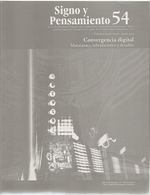Abstract
The numerous recorded technological creative revolutions have always brought about the emergence of new connections and relations and with them the blending, crossing, birth, and conformation of new identities. In other words, the many technological means have been acting all along history as factors that modify the ways in which culture is approached and appropriated in the regions were they have intervened or been incorporated. This paper is an attempt to shed light on the interactions that take place among subjects using the web and how therefore, an identity of shorts is created while the users constitute themselves as subjects. It has to be said though, that to do so, it is necessary to take note of the production of texts, since they are in fact the bases upon which the subject becomes visible in virtual spaces
Bajtín, M. (1982), Estética de la creación verbal, Buenos Aires, Siglo Veintiuno.
Barthes, R (1988)., La aventura semiológica, Buenos Aires, Paidós.
Courtés, J.; Greimas, A. (1982), Semiótica. Diccionario razonado de la teoría del lenguaje, Madrid, Gredos.
Ducrot, O. y Todorov, T. (2003), Diccionario enciclopédico de las ciencias del lenguaje, Buenos Aires, Siglo XXI.
Eco, U. (1999), Kant y el ornitorrinco, Barcelona, Lumen. Eco, U. (2000), Tratado de semiótica general, Barcelona, Lumen.
Enríquez Ríos, E. (2007), “La construcción de la imagen presidencial: el debate televisivo”, en Escudero, Lucrecia y García, Claudia (coord.) Democracias de opinión. Medios y comunicación política. Buenos Aires, La Crujía.
Halliday, M. A. K. (1982), El lenguaje como semiótica social, México, Fondo de Cultura Económica.
Hjelmslev, L. (1980), Prolegómenos a una teoría del lenguaje, Madrid, Gredos.
Jakobson, R. (1986), Ensayos de lingüística general, México, Planeta.
Jurado, A. (2007), “Semióticas del cine”, en Colección de semiótica latinoamericana, núm. 5, México. Lévy, P. (1999), ¿Qué es lo virtual?, México, Paidós.
Magariños de Morentín,J. (1996), Los fundamentos lógicos de la semiótica, Buenos Aires, Edicial.
Maingueneau, D. (1999), Términos clave del análisis del discurso, Buenos Aires, Nueva Visión.
Parret, H. (1983), Semiótica y pragmática, Buenos Aires, Edicial.
Peirce, C. S. (1987), Obra lógico semiótica, Madrid, Taurus.
Traversa, O. (2007), “Regreso a pantallas”, en: Dossier de estudios semióticos. La trama de la comunicación, vol. 12, unr Editora, Bogotá.
Ugarte, M. (2008), “Lo último del tiempo”, “La trama de la comunicación”, vol. 13, unr Editora, Bogotá.
Verón, E. (1987), “La palabra adversativa”. El discurso político, Buenos Aires, Hachette.
Zamora, M., “Redes sociales en internet”, en: Maestros del web [en línea], disponible en http://www.maestrosdelweb.com/editorial/redessociales/
Zecchetto, V. (1999), Seis semiólogos en busca del lector, Buenos Aires, La Crujía.
This journal is registered under a Creative Commons Attribution 4.0 International Public License. Thus, this work may be reproduced, distributed, and publicly shared in digital format, as long as the names of the authors and Pontificia Universidad Javeriana are acknowledged. Others are allowed to quote, adapt, transform, auto-archive, republish, and create based on this material, for any purpose (even commercial ones), provided the authorship is duly acknowledged, a link to the original work is provided, and it is specified if changes have been made. Pontificia Universidad Javeriana does not hold the rights of published works and the authors are solely responsible for the contents of their works; they keep the moral, intellectual, privacy, and publicity rights.
Approving the intervention of the work (review, copy-editing, translation, layout) and the following outreach, are granted through an use license and not through an assignment of rights. This means the journal and Pontificia Universidad Javeriana cannot be held responsible for any ethical malpractice by the authors. As a consequence of the protection granted by the use license, the journal is not required to publish recantations or modify information already published, unless the errata stems from the editorial management process. Publishing contents in this journal does not generate royalties for contributors.


